Xinyue Wei
Cosmos World Foundation Model Platform for Physical AI
Jan 07, 2025



Abstract:Physical AI needs to be trained digitally first. It needs a digital twin of itself, the policy model, and a digital twin of the world, the world model. In this paper, we present the Cosmos World Foundation Model Platform to help developers build customized world models for their Physical AI setups. We position a world foundation model as a general-purpose world model that can be fine-tuned into customized world models for downstream applications. Our platform covers a video curation pipeline, pre-trained world foundation models, examples of post-training of pre-trained world foundation models, and video tokenizers. To help Physical AI builders solve the most critical problems of our society, we make our platform open-source and our models open-weight with permissive licenses available via https://github.com/NVIDIA/Cosmos.
MeshFormer: High-Quality Mesh Generation with 3D-Guided Reconstruction Model
Aug 19, 2024
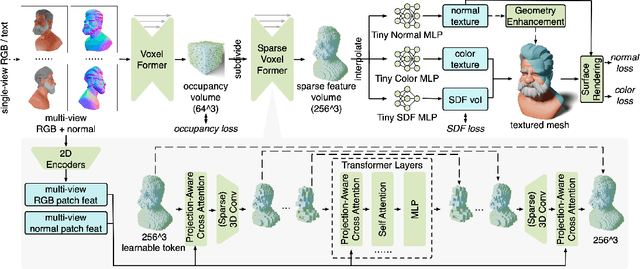

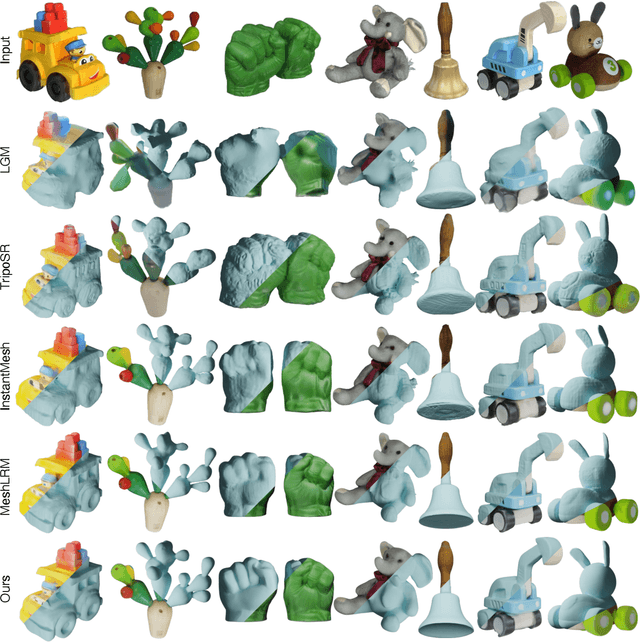
Abstract:Open-world 3D reconstruction models have recently garnered significant attention. However, without sufficient 3D inductive bias, existing methods typically entail expensive training costs and struggle to extract high-quality 3D meshes. In this work, we introduce MeshFormer, a sparse-view reconstruction model that explicitly leverages 3D native structure, input guidance, and training supervision. Specifically, instead of using a triplane representation, we store features in 3D sparse voxels and combine transformers with 3D convolutions to leverage an explicit 3D structure and projective bias. In addition to sparse-view RGB input, we require the network to take input and generate corresponding normal maps. The input normal maps can be predicted by 2D diffusion models, significantly aiding in the guidance and refinement of the geometry's learning. Moreover, by combining Signed Distance Function (SDF) supervision with surface rendering, we directly learn to generate high-quality meshes without the need for complex multi-stage training processes. By incorporating these explicit 3D biases, MeshFormer can be trained efficiently and deliver high-quality textured meshes with fine-grained geometric details. It can also be integrated with 2D diffusion models to enable fast single-image-to-3D and text-to-3D tasks. Project page: https://meshformer3d.github.io
MeshLRM: Large Reconstruction Model for High-Quality Mesh
Apr 18, 2024



Abstract:We propose MeshLRM, a novel LRM-based approach that can reconstruct a high-quality mesh from merely four input images in less than one second. Different from previous large reconstruction models (LRMs) that focus on NeRF-based reconstruction, MeshLRM incorporates differentiable mesh extraction and rendering within the LRM framework. This allows for end-to-end mesh reconstruction by fine-tuning a pre-trained NeRF LRM with mesh rendering. Moreover, we improve the LRM architecture by simplifying several complex designs in previous LRMs. MeshLRM's NeRF initialization is sequentially trained with low- and high-resolution images; this new LRM training strategy enables significantly faster convergence and thereby leads to better quality with less compute. Our approach achieves state-of-the-art mesh reconstruction from sparse-view inputs and also allows for many downstream applications, including text-to-3D and single-image-to-3D generation. Project page: https://sarahweiii.github.io/meshlrm/
ZeroRF: Fast Sparse View 360° Reconstruction with Zero Pretraining
Dec 14, 2023
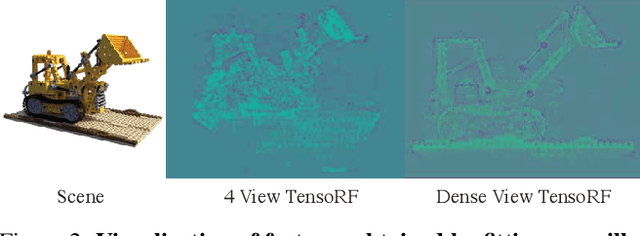


Abstract:We present ZeroRF, a novel per-scene optimization method addressing the challenge of sparse view 360{\deg} reconstruction in neural field representations. Current breakthroughs like Neural Radiance Fields (NeRF) have demonstrated high-fidelity image synthesis but struggle with sparse input views. Existing methods, such as Generalizable NeRFs and per-scene optimization approaches, face limitations in data dependency, computational cost, and generalization across diverse scenarios. To overcome these challenges, we propose ZeroRF, whose key idea is to integrate a tailored Deep Image Prior into a factorized NeRF representation. Unlike traditional methods, ZeroRF parametrizes feature grids with a neural network generator, enabling efficient sparse view 360{\deg} reconstruction without any pretraining or additional regularization. Extensive experiments showcase ZeroRF's versatility and superiority in terms of both quality and speed, achieving state-of-the-art results on benchmark datasets. ZeroRF's significance extends to applications in 3D content generation and editing. Project page: https://sarahweiii.github.io/zerorf/
One-2-3-45++: Fast Single Image to 3D Objects with Consistent Multi-View Generation and 3D Diffusion
Nov 14, 2023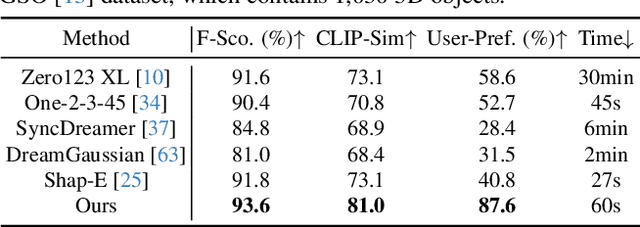


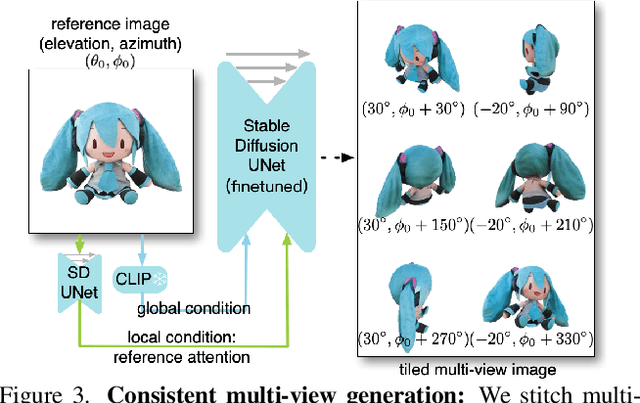
Abstract:Recent advancements in open-world 3D object generation have been remarkable, with image-to-3D methods offering superior fine-grained control over their text-to-3D counterparts. However, most existing models fall short in simultaneously providing rapid generation speeds and high fidelity to input images - two features essential for practical applications. In this paper, we present One-2-3-45++, an innovative method that transforms a single image into a detailed 3D textured mesh in approximately one minute. Our approach aims to fully harness the extensive knowledge embedded in 2D diffusion models and priors from valuable yet limited 3D data. This is achieved by initially finetuning a 2D diffusion model for consistent multi-view image generation, followed by elevating these images to 3D with the aid of multi-view conditioned 3D native diffusion models. Extensive experimental evaluations demonstrate that our method can produce high-quality, diverse 3D assets that closely mirror the original input image. Our project webpage: https://sudo-ai-3d.github.io/One2345plus_page.
Zero123++: a Single Image to Consistent Multi-view Diffusion Base Model
Oct 23, 2023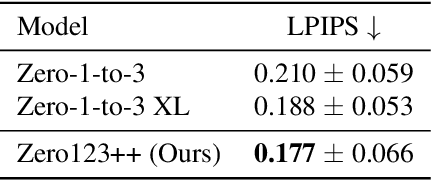
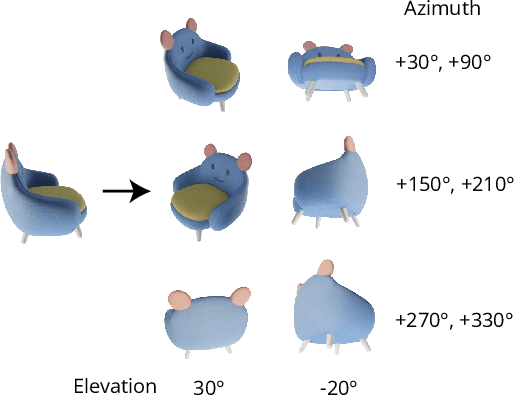
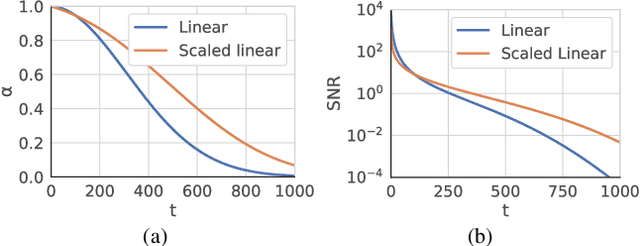
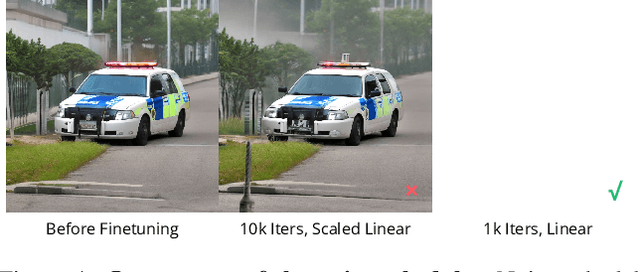
Abstract:We report Zero123++, an image-conditioned diffusion model for generating 3D-consistent multi-view images from a single input view. To take full advantage of pretrained 2D generative priors, we develop various conditioning and training schemes to minimize the effort of finetuning from off-the-shelf image diffusion models such as Stable Diffusion. Zero123++ excels in producing high-quality, consistent multi-view images from a single image, overcoming common issues like texture degradation and geometric misalignment. Furthermore, we showcase the feasibility of training a ControlNet on Zero123++ for enhanced control over the generation process. The code is available at https://github.com/SUDO-AI-3D/zero123plus.
NeuManifold: Neural Watertight Manifold Reconstruction with Efficient and High-Quality Rendering Support
May 26, 2023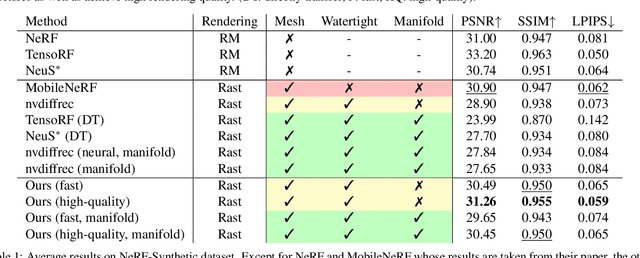
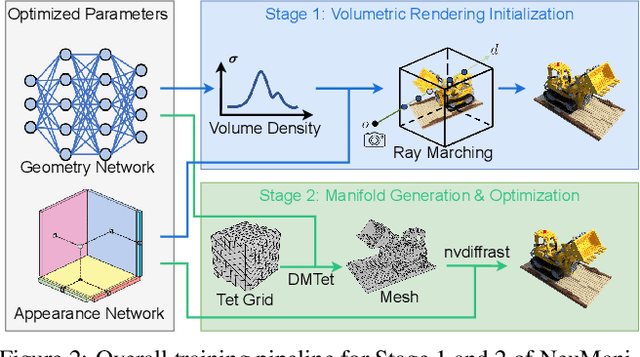

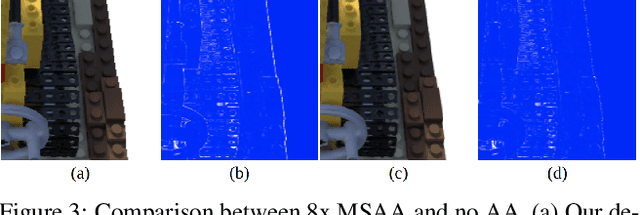
Abstract:We present a method for generating high-quality watertight manifold meshes from multi-view input images. Existing volumetric rendering methods are robust in optimization but tend to generate noisy meshes with poor topology. Differentiable rasterization-based methods can generate high-quality meshes but are sensitive to initialization. Our method combines the benefits of both worlds; we take the geometry initialization obtained from neural volumetric fields, and further optimize the geometry as well as a compact neural texture representation with differentiable rasterizers. Through extensive experiments, we demonstrate that our method can generate accurate mesh reconstructions with faithful appearance that are comparable to previous volume rendering methods while being an order of magnitude faster in rendering. We also show that our generated mesh and neural texture reconstruction is compatible with existing graphics pipelines and enables downstream 3D applications such as simulation. Project page: https://sarahweiii.github.io/neumanifold/
ManiSkill2: A Unified Benchmark for Generalizable Manipulation Skills
Feb 09, 2023Abstract:Generalizable manipulation skills, which can be composed to tackle long-horizon and complex daily chores, are one of the cornerstones of Embodied AI. However, existing benchmarks, mostly composed of a suite of simulatable environments, are insufficient to push cutting-edge research works because they lack object-level topological and geometric variations, are not based on fully dynamic simulation, or are short of native support for multiple types of manipulation tasks. To this end, we present ManiSkill2, the next generation of the SAPIEN ManiSkill benchmark, to address critical pain points often encountered by researchers when using benchmarks for generalizable manipulation skills. ManiSkill2 includes 20 manipulation task families with 2000+ object models and 4M+ demonstration frames, which cover stationary/mobile-base, single/dual-arm, and rigid/soft-body manipulation tasks with 2D/3D-input data simulated by fully dynamic engines. It defines a unified interface and evaluation protocol to support a wide range of algorithms (e.g., classic sense-plan-act, RL, IL), visual observations (point cloud, RGBD), and controllers (e.g., action type and parameterization). Moreover, it empowers fast visual input learning algorithms so that a CNN-based policy can collect samples at about 2000 FPS with 1 GPU and 16 processes on a regular workstation. It implements a render server infrastructure to allow sharing rendering resources across all environments, thereby significantly reducing memory usage. We open-source all codes of our benchmark (simulator, environments, and baselines) and host an online challenge open to interdisciplinary researchers.
Factor Fields: A Unified Framework for Neural Fields and Beyond
Feb 02, 2023
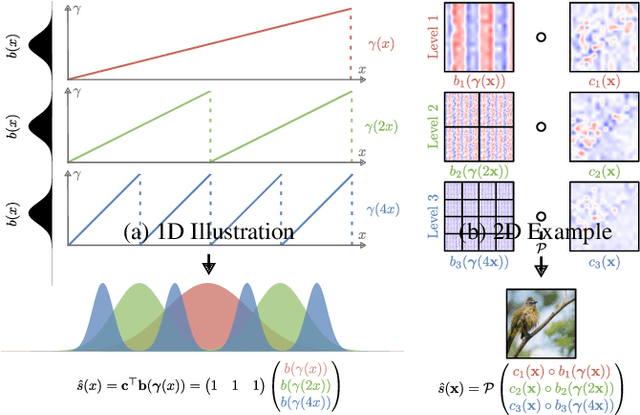
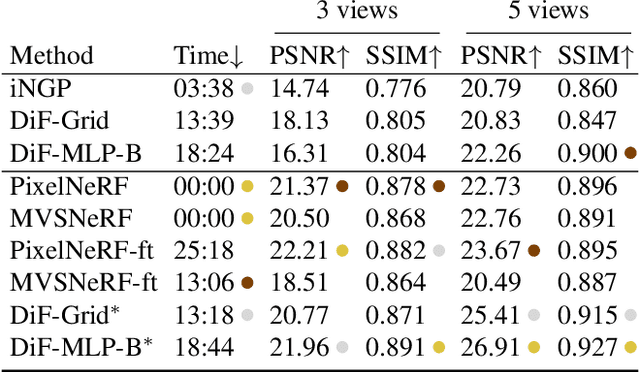
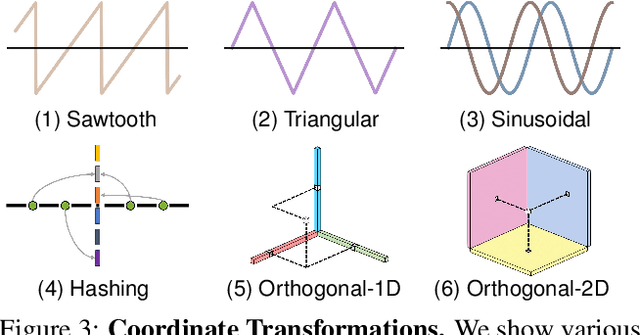
Abstract:We present Factor Fields, a novel framework for modeling and representing signals. Factor Fields decomposes a signal into a product of factors, each of which is represented by a neural or regular field representation operating on a coordinate transformed input signal. We show that this decomposition yields a unified framework that generalizes several recent signal representations including NeRF, PlenOxels, EG3D, Instant-NGP, and TensoRF. Moreover, the framework allows for the creation of powerful new signal representations, such as the Coefficient-Basis Factorization (CoBaFa) which we propose in this paper. As evidenced by our experiments, CoBaFa leads to improvements over previous fast reconstruction methods in terms of the three critical goals in neural signal representation: approximation quality, compactness and efficiency. Experimentally, we demonstrate that our representation achieves better image approximation quality on 2D image regression tasks, higher geometric quality when reconstructing 3D signed distance fields and higher compactness for radiance field reconstruction tasks compared to previous fast reconstruction methods. Besides, our CoBaFa representation enables generalization by sharing the basis across signals during training, enabling generalization tasks such as image regression with sparse observations and few-shot radiance field reconstruction.
Approximate Convex Decomposition for 3D Meshes with Collision-Aware Concavity and Tree Search
May 05, 2022
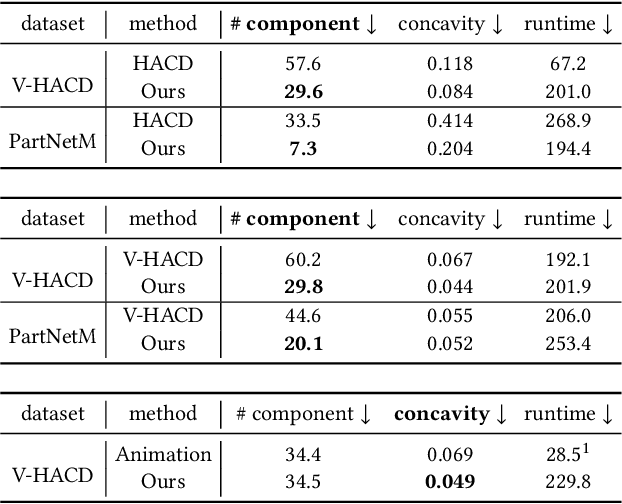
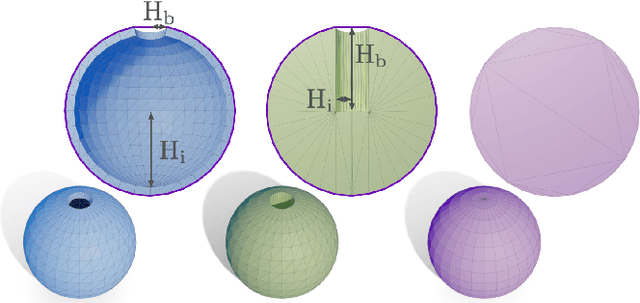

Abstract:Approximate convex decomposition aims to decompose a 3D shape into a set of almost convex components, whose convex hulls can then be used to represent the input shape. It thus enables efficient geometry processing algorithms specifically designed for convex shapes and has been widely used in game engines, physics simulations, and animation. While prior works can capture the global structure of input shapes, they may fail to preserve fine-grained details (e.g., filling a toaster's slots), which are critical for retaining the functionality of objects in interactive environments. In this paper, we propose a novel method that addresses the limitations of existing approaches from three perspectives: (a) We introduce a novel collision-aware concavity metric that examines the distance between a shape and its convex hull from both the boundary and the interior. The proposed concavity preserves collision conditions and is more robust to detect various approximation errors. (b) We decompose shapes by directly cutting meshes with 3D planes. It ensures generated convex hulls are intersection-free and avoids voxelization errors. (c) Instead of using a one-step greedy strategy, we propose employing a multi-step tree search to determine the cutting planes, which leads to a globally better solution and avoids unnecessary cuttings. Through extensive evaluation on a large-scale articulated object dataset, we show that our method generates decompositions closer to the original shape with fewer components. It thus supports delicate and efficient object interaction in downstream applications. We will release our implementation to facilitate future research.
 Add to Chrome
Add to Chrome Add to Firefox
Add to Firefox Add to Edge
Add to Edge